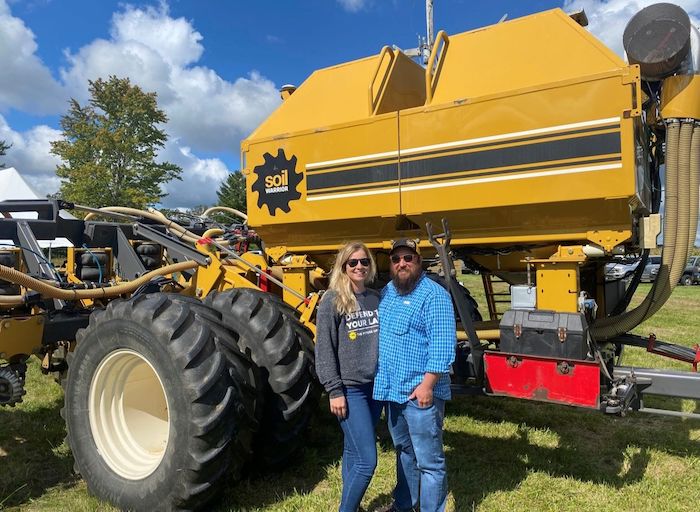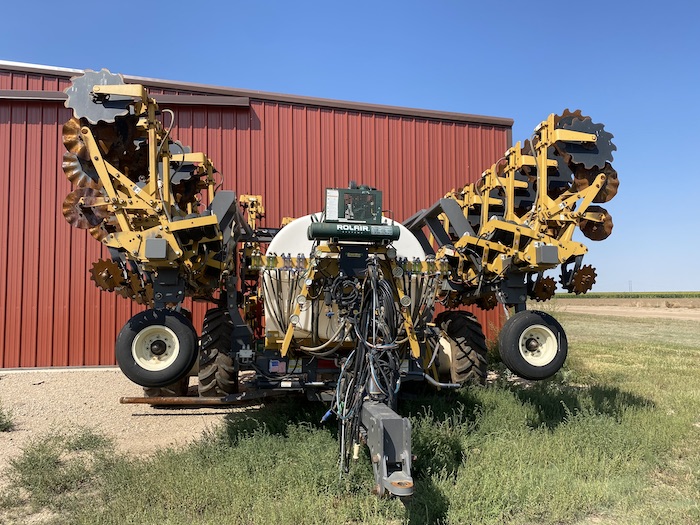A common objective to new practices among farmers is, "It won't work for my farm." We hear it all the time, especially when it comes to strip-till. Many are concerned about potential yield reductions or are hesitant to deviate from familiar farming practices that they have been using for generations.
Join us on a journey across North America to explore how the Environmental Tillage Systems (ETS) SoilWarrior® is being used by strip-tillers in various soils, climates and environments.
Strip-Till in the Midwest
Meet Ryan and Melissa Shaw from Marlette, Mich. They defied convention by selling most of their tillage equipment, opting to farm their entire 1,600 acres solely with the SoilWarrior. Shaw's bold move, while deemed risky by some, was an easy choice for the family. Ryan doesn’t need the other equipment as the SoilWarrior covers multiple bases for his farm, from cultivating strips to precise fertilizer application.
The Shaws use controlled traffic as well as twin-row planting, which throws an additional challenge into strip-till farming. Thanks to RTK guidance technology and the SoilWarrior’s steerable cart, they are able to prepare the seedbed in the right place and put the seed right where it needs to be.
“This has given us more opportunity to look at what each field needs individually,” Shaw says. “We’re able to take care of the land and get more out of it.”
In Blooming Prairie, Minn., Mike Trom has been reaping the benefits of his SoilWarrior for nearly a decade. Yet, his decision didn’t happen overnight.
Frustrated with stagnant soybean yields and using so much fuel for multiple passes, Trom began to investigate and looked heavily into the numbers for purchasing a SoilWarrior. The first thing he looked for was the ROI. He wanted to make the right investment that would save him money in future years to come.
Reflecting on his investment, Trom explained, “Switching to a strip-till system has saved me time, fuel and nutrient placement for crop availability."
CADA Farms in Cooper County, Mo., face the challenges of terraced ground and heavy clay soil. They have been able to use turkey manure from their farm as a fertilizer source for many years. Yet, they have struggled with preparing a consistent seedbed, minimizing soil disturbance and combating a slab effect in the heavy clay Missouri soil.
The family found it important to invest in a fertilizer tender and a good row blockage monitor. They were able to adapt an air delivery system on the SoilWarrior to help clear application lines when filling the fertilizer box.
The SoilWarrior proved to be a game-changer, aiding in erosion control, reducing fertilizer rates by 20-24% due to precision placement and increasing stands for both corn and soybeans on their strip-tilled acreage.
Hatley, Wis. - Fischer-Clark Dairy
Manure application is often a logistical issue noted by dairy farmers considering strip-till.
“It’s probably the biggest challenge,” says Mike Fisher of Fishcer-Clark Dairy. “It’s one of the reasons people will say dairy farming and strip-tilling won’t work. We decided right from the get-go that we would make it work.”
Fischer-Clark Dairy worked around this challenge by applying manure during the summer between crops. They could apply in the spring and fall, but only if it didn’t interfere with planting or harvesting.
“We realized it was better for us to put the manure on between crops,” Fischer says. “Now we’re doing that and interseeding grass in the alfalfa.”
Since adding the grass to the rotation, the fields are firmer and more resistant to erosion and soil compaction.
“Adding the grass, we have changed that equation, and the yield keeps increasing,” Fischer says. “It’s also improved the cows' health. Having grass in the mixture is good for a ruminant. The cows are healthier, our yield has improved and one thing led to the next.”
Strip-Till in the South
In Texas, Lone Star Family Farms found the SoilWarrior to be the ideal solution for reducing tillage without fully committing to no-till. The SoilWarrior's versatility allows them to navigate heavy field debris while ensuring a consistent seedbed and optimizing overall crop performance.
Lone Star Family Farms first began with no-till and found it wasn’t the right solution for them.
“We went from conventional tillage to straight no-till from one year to the next, and we got our tails kicked twice on that deal,” Scott Burdge says. “With the use of the SoilWarrior, we are getting a consistent seedbed. We can run the SoilWarrior in wetter conditions than we can run with a shank. The SoilWarrior gives almost the exact same seedbed every time, which helps the planter which in turn helps the overall yield stands.”
Strip-Till in the Northeast
Mike Verdonck tried no-till but still was not seeing the results he wanted. He continued searching for something that would work on his farm, and strip-till was on the list. Mike tried it on a few acres to see what it could do for his corn, soybean, wheat and canning crops.
In 2012, Verdonck purchased his first SoilWarrior. He made a few adjustments to the machine to be more compatible with his land, and after making these changes, he saw the results he wanted.
Verdonck believes there is not another machine on the market that can do what the SoilWarrior does. He understands that other machines work well, but when the SoilWarrior can do so much, that’s where it gets the edge.
“It can go through dead covers, living covers, high corn residue, or heavy clay with one pass and do a good job,” Verdonck says. “It’s a heavier machine, but it works well on wider spreads.”
Hudson Valley, N.Y.
Tom Jeffres was skeptical of the SoilWarrior at first because he wasn’t sure the coulters would get deep enough or that it was tough enough to handle his field conditions. After one season, he decided to give it another shot and expanded his system from 12 to 16 rows.
“The SoilWarrior helped us cover more acres faster with fewer overall breakdowns,” Jeffres says. “We did about 1,000-1,200 acres before stopping to repair or replace parts. With our last machine, we’d maybe go 100 acres at a time. Having less downtime is incredible.”
St. Thomas, Ontario
Mac Ferguson of St. Thomas, Ontario, strategically switched to strip-till with the SoilWarrior, aiming to streamline operations to a single pass for tillage, fertilizer application and cover crop seeding. The move resulted in substantial savings in labor, fuel consumption and depreciation.
Prior to purchasing a SoilWarrior in 2017, the Fergusons broadcasted their fertilizer and cover crop seed in separate passes with different equipment.
“Our switch to strip-till and the SoilWarrior purchase was very intentional,” says Ferguson, who uses it on about 85% of his acres. “We wanted to reduce passes across the field. With this system, we have one skilled operator doing tillage, applying fertilizer and cover crops in 40-foot swaths. That’s made a huge impact on our ROI.”
Ready to see how strip-till can improve your farm? Check out our SoilWarrior Systems or contact usfor more information on strip tillage.
Strip-Till Farmer's Building Healthier Soil and Profits with Strip-Till series is brought to you by Environmental Tillage Systems.
At Environmental Tillage Systems, we believe farmers shouldn’t have to choose between doing what’s right for your soil and what’s right for your business. The SoilWarrior is a complete precision zone tillage system custom built for your farm and delivered to you ready to get in the field. Backed by 24-hour service and support, The SoilWarrior takes the guess work out of strip-till so you can concentrate on defending the land and leading the charge. See soilwarrior.com for more information.









